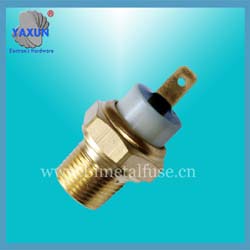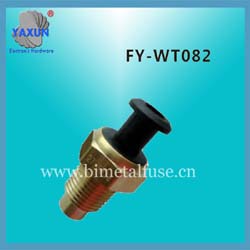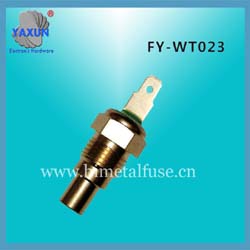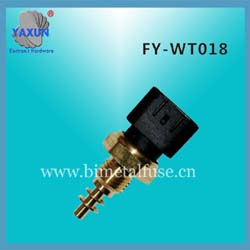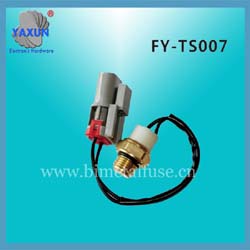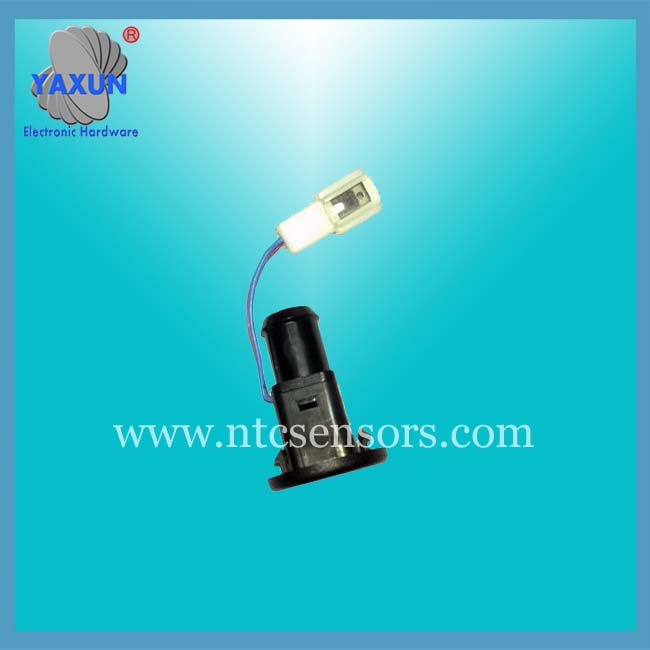Different car series Engine Block Motor Temperature Sensor
- PRODUCT DETAIL
Engine cylinder temperature sensor and its working principle
Thermistor temperature sensors are mainly composed of thermistors and lead wires. Thermistors made of semiconductor materials have resistance that changes with temperature. According to the law that the resistance changes with temperature, it can be divided into two types: negative temperature coefficient type (NTC type) and positive temperature coefficient type (PTC type). The resistance value of the negative temperature coefficient thermistor has a negative correlation with the change in temperature, that is, the resistance value decreases with increasing temperature. The resistance value of the PTC thermistor becomes larger as the temperature increases.
The engine cylinder temperature sensor is generally installed on the water jacket of the cylinder block or cylinder head and is in direct contact with the coolant. The engine ECU receives the coolant temperature sensor signal as a correction signal for engine fuel injection and ignition, and is also used to control the coolant fan, air conditioner, etc., its role cannot be underestimated. If the ECU accepts a distorted coolant temperature sensor signal, it will seriously affect the normal operation of the engine and even make it difficult to start the engine.
II. Interface type of coolant temperature sensor
1. Two-wire sensor. The two-wire sensor is shown in Figure 1. One terminal is the signal output terminal, which is connected to the ECU; The other terminal is the ground terminal and is grounded through the ECU ground terminal.
2. Three-wire sensor. The three-wire sensor is shown in Figure 2. The sensor contains a thermistor and a sensing plug. Except for the two wires from the thermistor (signal output and ground). There is another terminal, which is led out from the sensor plug inside the sensor and connected to the coolant temperature gauge on the instrument panel for the display of the coolant temperature gauge.
3. Four-wire sensor. The four-wire sensor is shown in Figure 3. The sensor is equipped with two thermistors, one connected to the ECU for computer control of the engine;
The other is for the display of the coolant temperature gauge. The two thermistors each lead out a signal line and a ground line.
Third, failure case analysis
1. Failure phenomenon: A Volkswagen Passat sedan, with a mileage of 120,000 km, had difficulty starting the engine in the morning. It needs to be started several times to get on the car. Everything is normal after entering the car, and there is no abnormal display on the dashboard. But now the engine can't start.
2. Troubleshooting.
The author's thoughts on the failure of the engine to start can be summarized as follows:
Battery failure or starter failure; If the starter runs strongly, check the ignition timing, fuel pressure, cylinder pressure, and fuel injection conditions. Turn on the ignition switch, the starter runs powerfully, and you can hear a "burst" sound from the exhaust pipe, but the engine cannot start the car. Connected to the decoder, no fault code is displayed. Enter the engine data stream group 001 and found that the coolant temperature is 92 ° C, which indicates that the coolant temperature sensor is faulty. Because the engine does not start at all, the coolant temperature cannot be so high. Then disconnected the coolant temperature sensor wire connector, and as a result, the engine started smoothly. When the connector is unplugged, the engine computer will default the coolant temperature to -46.5 ° C, increasing the fuel injection amount.
3. Failure analysis.
Engine fuel injection is controlled by engine speed and air intake. However, signals such as the coolant temperature sensor and the oxygen sensor will affect the correction value of the engine fuel injection. If these signals are distorted, it will seriously affect the engine starting performance. In this case, the engine needs a rich mixture during a cold start, and the vehicle's coolant temperature sensor is damaged, causing the engine control unit to always consider the coolant temperature to be 92 ° C. A richer mixture should have been needed, and as a result, the mixture was leaner, which prevented the engine from starting.
Why is the coolant temperature measured by the coolant temperature sensor at 92 ° C, and the abnormality of the coolant temperature on the dashboard is not found? Because the car's coolant temperature sensor is a four-wire sensor, its working principle is shown in Figure 3. Use a multimeter to measure the voltage between terminal 1 and terminal 3, there is no voltage display, and measure the voltage between terminal 2 and terminal 4, the voltage value is 1.25 V, the display is normal. It indicates that the thermistor that provided the signal to the ECU has been damaged, so a new coolant temperature sensor was replaced, and the fault was completely eliminated.
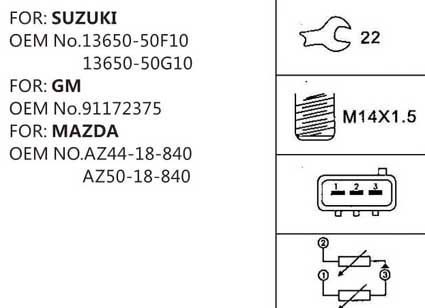
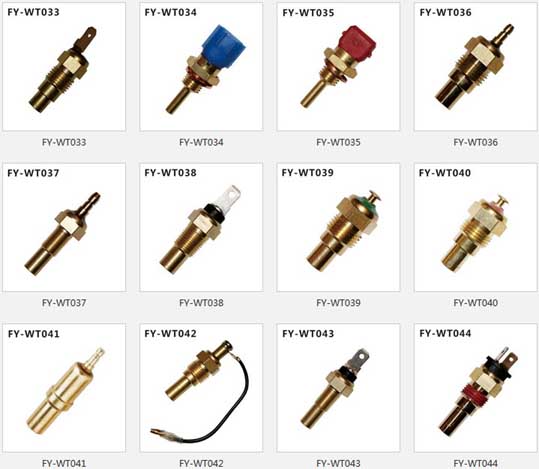
Thermistor temperature sensors are mainly composed of thermistors and lead wires. Thermistors made of semiconductor materials have resistance that changes with temperature. According to the law that the resistance changes with temperature, it can be divided into two types: negative temperature coefficient type (NTC type) and positive temperature coefficient type (PTC type). The resistance value of the negative temperature coefficient thermistor has a negative correlation with the change in temperature, that is, the resistance value decreases with increasing temperature. The resistance value of the PTC thermistor becomes larger as the temperature increases.
The engine cylinder temperature sensor is generally installed on the water jacket of the cylinder block or cylinder head and is in direct contact with the coolant. The engine ECU receives the coolant temperature sensor signal as a correction signal for engine fuel injection and ignition, and is also used to control the coolant fan, air conditioner, etc., its role cannot be underestimated. If the ECU accepts a distorted coolant temperature sensor signal, it will seriously affect the normal operation of the engine and even make it difficult to start the engine.
II. Interface type of coolant temperature sensor
1. Two-wire sensor. The two-wire sensor is shown in Figure 1. One terminal is the signal output terminal, which is connected to the ECU; The other terminal is the ground terminal and is grounded through the ECU ground terminal.
2. Three-wire sensor. The three-wire sensor is shown in Figure 2. The sensor contains a thermistor and a sensing plug. Except for the two wires from the thermistor (signal output and ground). There is another terminal, which is led out from the sensor plug inside the sensor and connected to the coolant temperature gauge on the instrument panel for the display of the coolant temperature gauge.
3. Four-wire sensor. The four-wire sensor is shown in Figure 3. The sensor is equipped with two thermistors, one connected to the ECU for computer control of the engine;
The other is for the display of the coolant temperature gauge. The two thermistors each lead out a signal line and a ground line.
Third, failure case analysis
1. Failure phenomenon: A Volkswagen Passat sedan, with a mileage of 120,000 km, had difficulty starting the engine in the morning. It needs to be started several times to get on the car. Everything is normal after entering the car, and there is no abnormal display on the dashboard. But now the engine can't start.
2. Troubleshooting.
The author's thoughts on the failure of the engine to start can be summarized as follows:
Battery failure or starter failure; If the starter runs strongly, check the ignition timing, fuel pressure, cylinder pressure, and fuel injection conditions. Turn on the ignition switch, the starter runs powerfully, and you can hear a "burst" sound from the exhaust pipe, but the engine cannot start the car. Connected to the decoder, no fault code is displayed. Enter the engine data stream group 001 and found that the coolant temperature is 92 ° C, which indicates that the coolant temperature sensor is faulty. Because the engine does not start at all, the coolant temperature cannot be so high. Then disconnected the coolant temperature sensor wire connector, and as a result, the engine started smoothly. When the connector is unplugged, the engine computer will default the coolant temperature to -46.5 ° C, increasing the fuel injection amount.
3. Failure analysis.
Engine fuel injection is controlled by engine speed and air intake. However, signals such as the coolant temperature sensor and the oxygen sensor will affect the correction value of the engine fuel injection. If these signals are distorted, it will seriously affect the engine starting performance. In this case, the engine needs a rich mixture during a cold start, and the vehicle's coolant temperature sensor is damaged, causing the engine control unit to always consider the coolant temperature to be 92 ° C. A richer mixture should have been needed, and as a result, the mixture was leaner, which prevented the engine from starting.
Why is the coolant temperature measured by the coolant temperature sensor at 92 ° C, and the abnormality of the coolant temperature on the dashboard is not found? Because the car's coolant temperature sensor is a four-wire sensor, its working principle is shown in Figure 3. Use a multimeter to measure the voltage between terminal 1 and terminal 3, there is no voltage display, and measure the voltage between terminal 2 and terminal 4, the voltage value is 1.25 V, the display is normal. It indicates that the thermistor that provided the signal to the ECU has been damaged, so a new coolant temperature sensor was replaced, and the fault was completely eliminated.



